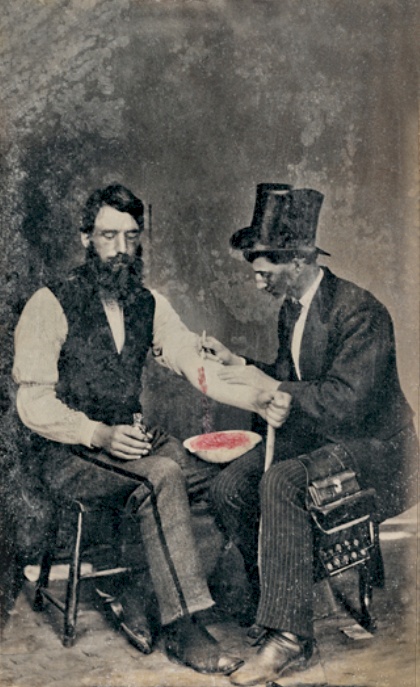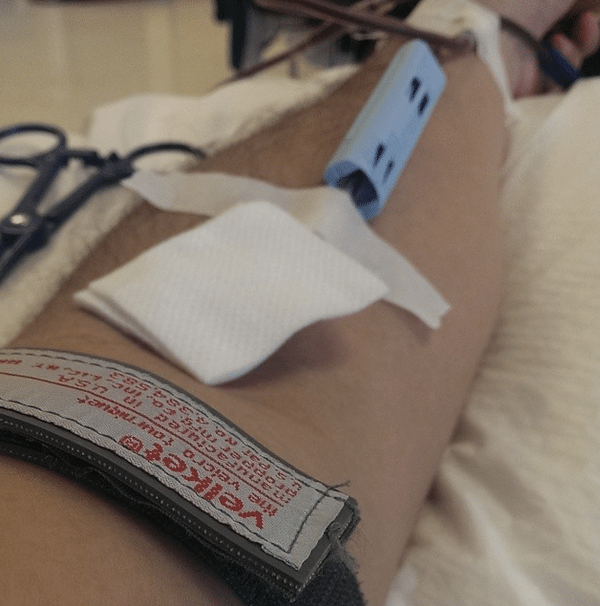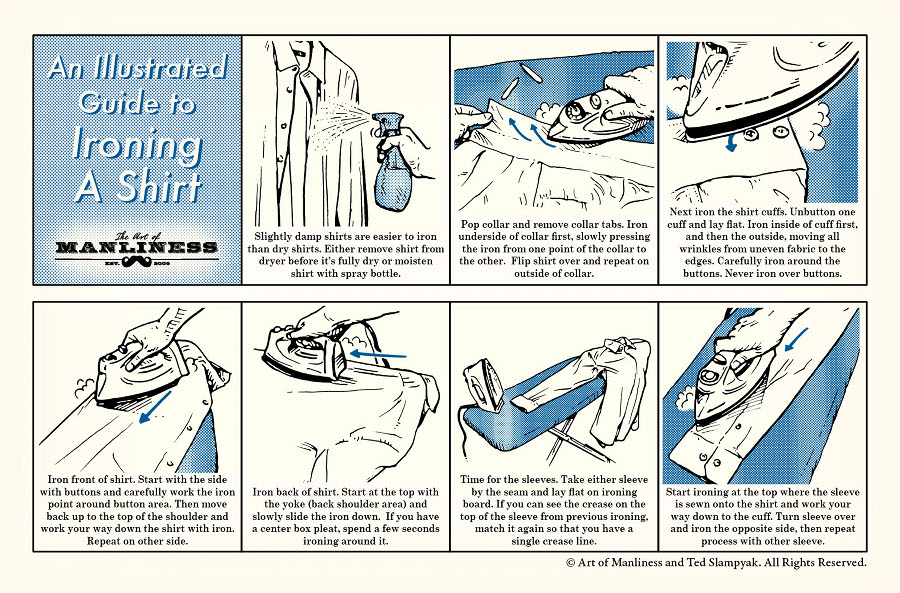
Bloodletting is one of the oldest medical practices in history. The earliest records of it for health purposes come from 3,000-year-old Egyptian texts. We also have texts indicating that Ancient Hindus bled sick individuals in the hopes of healing them. Ancient Syrians were known to use leeches for bloodletting as well. The practice was in fact common all over the world, right up until the late 19th century.
Despite three-millennia of global popularity, these days bloodletting is commonly considered one of the world’s most assuredly outdated medical practices. It’s become the go-to reference for jokes about barbaric quackery that harms instead of heals.
But what if it might be unwise to dismiss the practice of bloodletting completely? As wacky as it sounds, bloodletting might actually be good for people, especially for men. Below we cover a brief history of bloodletting, before taking a look at its potential real-life benefits. For real.
A Brief History of Bloodletting

In Western medicine, bloodletting was based on the ancient Greek idea that the human body was composed of four humors (or bodily fluids): blood, phlegm, black bile, and yellow bile, which corresponded to the four Greek classical elements of air, water, earth, and fire, respectively. All sickness was thought to be the result of an imbalance of the humors in the body and the job of the doctor was to bring them back into equilibrium. Inducing vomiting, ingesting diuretics, and draining the body of blood were thought to be effective ways to harmonize the four humors. The famous Greek physician Hippocrates believed that bloodletting was an externally-induced parallel to female menstruation, which functioned to “purge women of bad humors.” After likely being passed on from the Greeks, Islamic authors also advocated for the practice, and soon bloodletting became prevalent throughout both European and Arabic countries.
Bloodletting was thought to be beneficial in healing nearly every disease, from acne and asthma, to cancer and smallpox. Even the loss of blood from a wound was treated by…removing more blood! Bloodletting the already-wounded was thought to reduce inflammation (which is why it was employed prior to surgery as well). Bloodletting wasn’t limited to curing disease either, but was also used as a preventive measure to avoid getting sick.

The methods and tools to draw blood from sick patients also varied widely. Leeches were a common bloodletting implement for those times when a doctor felt a slower, more controlled blood loss was called for; in the 1830s, France imported over 40 million leeches to be used for this purpose! For faster blood loss, sharpened sticks, shark’s teeth, knives, and arrow points were used to “breathe” a vein in the neck or forearm or an artery in the forehead. There was even a specific tool for the job – a spring-loaded, multi-bladed mechanism called the scarificator. The most common bloodletting instrument, however, was actually the barber’s straight razor.

For centuries, the local barber not only offered close shaves and sharp haircuts, but also provided medical services including bloodletting. In fact, the iconic barbershop pole with its two brass balls and red and white stripes is a vestige of the days when barbers would slit customers’ arms to relieve their ailments. The brass ball at top represents the bowl that the barbers kept leeches in for drawing blood, and the brass ball at the bottom of the pole represents the bowl the barbers used to catch blood from their patients/customers. The red represents blood, while white stripes symbolize the bandages that barbers would hang on a pole to dry after washing. The pole itself may represent a stick that patients would grip during the bloodletting procedure to encourage blood flow.
Bloodletting reached its peak in the 18th and 19th centuries. Doctors from that time often bled patients until they fainted, which to them was a sign that they removed just the riiight amount of blood. Some historians speculate that what killed George Washington wasn’t his respiratory infection, but rather the shock of undergoing four (four!) bleedings within 24 hours.
After a three-millennia run of being the go-to treatment for every ailment under the sun, the effectiveness of bloodletting was strongly questioned in the late 19th century, and had been almost completely abandoned by the medical establishment by the dawn of the 20th. We now laugh and roll our eyes at our ancient forbearers for their childish and barbaric naivety to think that purposely bleeding could heal sickness.
And yet as it turns out, there might be some benefits to bloodletting after all. As genetic physician Sharon Moalem notes in his book Survival of the Sickest, “the notion that humans across the globe continued to practice [bloodletting] for thousands of years probably indicates that it produced some positive results. If everyone who was treated with bloodletting died, its practitioners would have been out of business pretty quickly.”
Well, recent research suggests our ancestors may have been on to something when they sliced each other open or stuck leeches on their faces, as controlled (emphasis on controlled) bloodletting potentially provides a myriad of health benefits.
The Benefits of Controlled Bloodletting (AKA Phlebotomy, AKA Donating Blood)
Most of the benefits of bloodletting are related to iron, so to understand bloodletting’s positive effect, you must first understand the role this mineral plays in our bodies.
Iron and Health
Our bodies need iron for a whole host of metabolic processes. Its primary function is to help carry oxygen from our lungs through the bloodstream and release it to the body where needed. What’s more, iron helps enzymes in the body detoxify poisons and convert sugars into energy. When a person has anemia, or an iron deficiency, they look pale, feel fatigued, and are easily confused and disoriented.
But here’s the thing: Our bodies aren’t the only organisms that require iron to survive and thrive. Little tiny organisms that can make us sick also need this mineral. When bacteria, fungi, and protozoa enter our body, they immediately hunt for iron so they can survive and spread.
The connection between iron and bacteria growth was discovered accidently by a research assistant of scientist Eugene D. Weinberg. Weinberg was investigating whether diet could mitigate the effectiveness of antibiotics, so he and his team filled petri dishes with bacteria, an antibiotic, and an organic or elemental nutrient (that varied from dish to dish). A few days later, a research assistant noticed that one dish was so jam-packed with bacteria, that she thought she had forgotten to put in the antibiotic. So she created the dish again, making sure the antibiotic was in there, and sure enough when she came back a few days later, the dish was once again overloaded with bacteria.
Can you guess which elemental nutrient was also in the dish? You got it: iron. The iron was such a boon to the bacteria that it completely counteracted the efficacy of the antibiotic.
Because potentially infectious agents require iron to survive and thrive, the access points on our bodies — mouth, eyes, nose, anus, and genitals — are iron-free zones. Proteins called chelators patrol our bodies’ openings and lock up any stray iron molecules in those areas so that bacteria and the like can’t use the iron to survive and possibly spread to other parts of the body.
But let’s say some nasty bug gets past this first line of defense and you get sick with something. Well, part of the body’s immune response is to reduce the amount of iron circulating in your blood so that the infectious agent can’t use it to multiply. Something similar happens when cells become cancerous. Cancer cells need iron to grow and spread, so the less iron available, the harder it is for the cancer to thrive. Of course in many cases, the body’s natural iron reduction isn’t enough to stop the spread of the cancer, but the body gives it a try nonetheless.
The Benefits of Bloodletting

While our bodies need iron for nearly every function of our metabolism, an excess of this mineral can leave us more vulnerable to sickness and ill-health. In an age where a lot of our food is fortified with iron, many Westerners likely have too much of it floating around in their system (especially men, as we’ll explain in a bit). Because iron resides primarily in our blood, periodically letting some of it out may help bring balance back to our bodies (the ancient Greeks were on to something after all!). This is especially true if you have the genetic disorder hemochromatosis, which makes your body store excess amounts of iron, necessitating regular bloodlettings. But even if you don’t have hemochromatosis, you may stand to benefit from getting rid of some blood every now and then. Below I highlight some of the possible health benefits of donating blood on a regular basis:
May help stave of illnesses. When you donate blood, you’re reducing the amount of iron in your body. Based on what we know about how infectious agents use iron to survive and grow, reducing iron levels through blood donation may theoretically help stave off illnesses. At least that’s what some researchers and doctors like Sharon Moalem theorize.
Moalem points to a few incidents to bolster this theory. The first was in a Somali refugee camp where diseases like malaria, tuberculosis, and brucellosis were present. Despite the prevalence of these diseases, very few of the refugees showed signs of infection. A doctor named John Murray had a hunch that their low levels of iron due to malnutrition were contributing to the immunity of the nomads in the camp. To test his theory, he gave half of them iron supplements to treat the anemia they were all experiencing. The other half continued on their regular diets. Sure enough, the rates of infection went through the roof among the refugees who received the iron supplements. Something similar happened in New Zealand when doctors injected babies with iron supplements. Infections increased dramatically.
While I couldn’t find any studies that directly showed a connection between donating blood and reducing illness, those anecdotal examples provide a starting point for an argument that reducing iron levels though blood donation may help stave off sickness. If anyone is aware of research on this topic, I’d love to be directed to it.
May reduce risk for cancer. A few studies suggest there’s a connection between reducing iron through blood donation and reducing cancer risks. For example, one study found that individuals who underwent iron reduction through phlebotomy to improve vascular health also saw a decreased cancer risk. Another study also found an inverse relationship between iron levels and cancer risk, particularly in men. However, a 2008 study found no such connection between iron levels and cancer levels; what’s more, the researchers found no connection between regular blood donation and reduced cancer risks. Researchers are still exploring the connection between blood donation, iron reduction, and cancer risk, and while the results aren’t definitive, if something as simple as donating blood has the possibility of reducing my risk, I’m all for it.

Reduces hardening of the arteries and heart attack risk. A study of nearly 3,000 middle-aged men found that those who regularly donated blood had 88% less risk of heart attack. Scientists have a few theories as to why this is. First, there’s the iron thing. Several studies have shown a connection between high iron levels and increased risk for cardiovascular diseases. One study found that high iron levels immediately constrict blood vessels and reduce blood flow in your circulatory system. When you have reduced blood flow in your arteries, they begin to harden. What’s more, high iron levels in the blood can oxidize cholesterol, and the product of this oxidation deposits itself on the walls of your arteries causing build up which can lead to heart attacks and strokes.
Besides reducing iron levels, donating blood on a regular basis also reduces blood viscosity, or thickness. Blood that’s too thick doesn’t transport nutrients to your tissues as well. Generally, men have more circulatory problems due to high blood viscosity than pre-menopausal women. Researchers theorize that a woman’s monthly period helps keep blood viscosity in check.
Finally, donating blood on a regular basis can help keep cardiovascular problems at bay because with each visit you basically get a mini-physical that checks your cardiovascular health. Each time you donate blood, you’ll find out your blood pressure, pulse, and cholesterol levels. You can use that info to make changes in your lifestyle if they’re creeping to levels that put you at risk for cardiovascular problems.
May improve insulin sensitivity, thus decreasing risk for type 2 diabetes. Excess iron can blunt insulin sensitivity, making you more susceptible to type 2 diabetes. Even if you’re not at risk of diabetes, studies have shown that donating blood regularly can help you stay lean and trim by reducing your body’s iron, thus increasing your insulin sensitivity.
For an in-depth look on the connection between iron reduction through blood donation and insulin sensitivity, check out this report from the American Diabetes Association.
Burns calories. A study by the University of California San Diego found that on average, you burn about 650 calories when you donate blood. Even after you eat your Nutter Butters afterward, you’ll still have burned 400 calories, just from reclining in a chair.
Regularly purging yourself of iron is particularly beneficial for men’s health. On average, men have more iron in their bodies than women — 4 grams versus 3.5. One reason for this appears to be a correlation between testosterone levels and iron levels; high testosterone suppresses a peptide called hepciden that regulates iron levels. Lower hepciden in men due to higher testosterone means higher iron levels.
Also, women lose 1 gram of iron each month when they menstruate, making iron deficiency a common disorder for this sex. Men, on the other hand, don’t have a natural way to keep iron levels in check. Iron deficiency isn’t a good thing, but excess iron isn’t either, and researchers believe one of the factors (among many) contributing to women’s longer life expectancy is that they simply have lower amounts of iron in their system compared to men thanks to reduced testosterone levels and monthly periods.
Start Bloodletting Today!

Make donating blood something you do with your best bro. And have a running joke with your significant other where you say, “Well, it’s that time of the month again!”
Instead of going to the barbershop for a good old-fashioned bloodletting, or letting a vampire bite you so you can become undead and have a vampire baby that’s imprinted on by a werewolf, you can visit your local American Red Cross or blood institute to donate a pint of blood. Besides providing a life-saving substance to someone in your community, you also may be reaping the health benefits above.
If there’s nothing preventing you from donating blood, make it a goal to donate on a regular basis. Most blood institutes allow you to do so every eight weeks.

I’d been a sporadic blood donater since high school, but ever since learning about its possible health benefits — particularly for men — I’ve made appointments to donate blood every two months well in advance.
Granted, it’s completely possible that donating blood on a regular basis is actually providing little health benefits to me. But I’m okay with that. There’s more to gain than to lose from donating blood. You’re getting rid of excess iron, which can possibly make your body healthier, and someone in your community gets potentially life-saving blood. If all this research turns out to be a bunch of hooey, at least I saved someone else’s life if not my own!
So what are you waiting for? Bring back bloodletting by making an appointment with your local blood institute or American Red Cross today.







